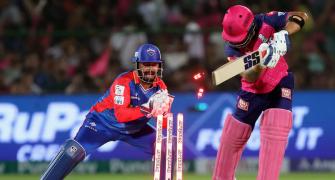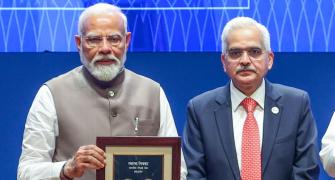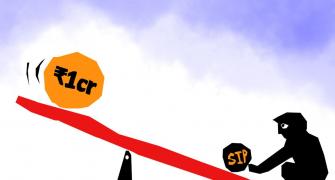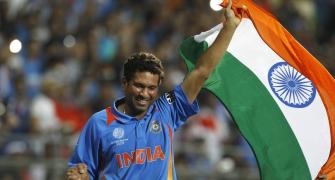Two middle-aged men dressed in suits greet each other with an extreme formality that would be more at home in the days of the Raj than in these current times. A super runs across the bottom of the screen: "Definitely not tea drinkers."
The next shot shows two casually dressed, slightly sloppy young men. One greets the other by smacking his head. The 'victim' appears angry, and a second later, jumps up and hugs the first boy. The super: "Definitely tea drinkers."
A voice-over follows - "Chai piyo mast jiyo" - against a visual of a steaming cup of tea and the brand name - Tea Board of India. Meanwhile, the two non-tea drinkers are still praising the beautiful morning. The young men appear on the scene, watch them for a bit and then one of them says loudly, "Good afternoon, Sir."
On air now, this is one of three television commercials commissioned by the Tea Board of India. The other two are variations on the same theme. One ad shows a young man proposing to a girl in an exaggeratedly pretentious manner; but before he can pop the question, another contender literally jumps into the fray, grabs the ring and slips it onto the girl's finger - and walks away with her.
In the third ad, the camera pans back and forth between two elderly couples greeting each other on their wedding anniversary. While the first couple solemnly exchange congratulations and greeting cards, the second husband turns up with a band belting out an old Bollywood number.
All three situations juxtapose tea-drinkers and non-tea drinkers, with the former inevitably emerging victorious. The ads were created by O&M and shot by ad film agency Footcandles at various places across Mumbai in just three weeks.
When the Tea Board, a public sector organisation that promotes Indian tea at home and abroad, called for pitches, its brief to the competing ad agencies was simple: portray tea as a contemporary, with-it beverage.
"We wanted to remove the image that tea is a fuddy-duddy drink that's outdated and drunk by old people. We wanted to showcase it as an exciting drink instead," says Basudeb Banerjee, chairman, Tea Board of India.
The need for such a campaign has been brewing for a while. Although India is largely considered a tea-drinking nation, per capita consumption is a weak 720 gm a year; compare that with Pakistan, where per capita tea consumption is 50 per cent higher, at over 1 kg a year.
India's reputation for tea drinking is driven by the volume consumed by the country, which is a function of its large population - in fact, it is the largest tea-drinking nation in the world.
That's not good enough. "Everyone drinks tea at home, but rarely order it outdoors. We're trying to tell them tea isn't an alien drink and they should feel comfortable ordering it in restaurants," says Sharmista Dev, general manager and head of office, O&M Kolkata, the agency behind the campaign.
Which is why the ads are specifically targeted at the segment that drinks the most beverages outside home: the 18- to 24-year-olds who can't do without their colas, cafe latté and other designer coffees served up at coffee bars across the country.
The message this time is that tea drinkers aren't just choosing a hot drink, they're choosing their lifestyle. That's a change from the Tea Board previous campaign, in 2001-02, where the focus was on health.
Created by FCB Ulka, the "Piyo ji bhar ke" ad also targeted younger audiences, showing people enjoying a cuppa after exercising or practising yoga. Interestingly, the rationale behind that campaign also was to make tea more relevant and hip. But that was just one ad, perhaps not enough to drive the message home.
"The previous campaign didn't really emphasise 'why' people should drink tea. The current campaign stresses on the fun aspect of tea," says Banerjee.
Besides, say market watchers, it was time the industry body helped boost the commodity. Most advertising in the tea market comes from branded tea players who account for Rs 3,100 crore (over 25 per cent) of the Rs 12,000 crore (Rs 120 billion) Indian tea market.
At Rs 6,500-7,000 crore (Rs 65 to 70 billion), the cola drinks market is half the size of the tea market, but advertises much more. Meanwhile, there's an increasing threat from coffee, which is being powered by the 25 per cent annual growth in modern format cafés. (Source: Technopak Advisors).
Tea as a category has been struck by a double whammy of increased competition and rapidly evolving consumer preferences. Not too long ago, guests were offered tea and, occasionally, coffee.
Now, there's a laundry list of options: carbonated drinks, fruit juices, non-alcoholic and semi-alcoholic drinks, a variety of coffees and fruit infusions, and even specialist teas imported from abroad. Tastes are changing even at the workplace.
"There's a sense that coffee is a more sophisticated drink than tea. So, several people drink more coffee in offices," contends Anand Halve, co-founder, Chlorophyll, a Mumbai-based consultancy.
As far as the Tea Board is concerned, that's unacceptable. It is spending Rs 3 crore to see if it can reverse that trend - and soon. Along with the television commercials are simultaneous broadcasts of ads on FM channels in the five metros, as well as All India Radio for a nation-wide coverage.
Follow-up print campaigns are also planned. These will be more informative, focusing on the types of tea - iced tea, green tea, chamomile and so on - and the distinct differences between them.
The Tea Board's effort go beyond just communication and include experiential marketing initiatives. Some months ago, the Board kicked off the 'Discover Tea' promotion, where it tied up with popular nightclubs in the metros to create tea-based cocktails. It is now planning tasting sessions at college canteens and malls.
Some earlier attempts at reaching potential customers have been fairly successful, too. Between 1999 and 2002, the state-owned Tea Centre outside Mumbai's Churchgate railway station was under the care of ad-man Prahlad Kakkar.
A known tea aficionado and, incidentally, the son-in-law of a tea planter, Kakkar's association with the foods business is well-documented. He had earlier turned around the café at Prithvi Theatre in suburban Mumbai, and now worked his wizardry at the Tea Centre, too.
Next on the list is a similar experiment in Kolkata's posh Park Street. "Tea consumption is either at roadside chai stalls or at five-star hotels. So, it's mostly about the poor or the very rich. There's nothing left in between for the middle class. We're looking at targeting this belt through ventures like Tea Centre," says Banerjee.
Giving tea some steam is a sudden interest in tea - it's now chic to drink tea at a tea or chai bar; the Bangalore-based Infinity and Darjeeling's Tea Cosy are popular tea bar chains.
Then, Modi Sugar Mills' brand Originale offers tea lovers sugar sachets for every flavour - tulsi , ginger, ginger-lemon, cardamom, earl grey and masala. Sugar brands like Dhampure have launched sugar syrups, cashing in on the growing popularity of iced tea.
Looks like the kettles are boiling, even without the Tea Board stoking the fires.
Who Did What
Client: Tea Board Of IndiaAgency: Ogilvy & Mather (O&M)
Creative: Sumanto Chattopadhyay
Client Servicing: Sharmista Dev







